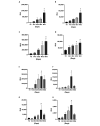Assessing Accumulation of Organic Material on Rodent Cage Accessories
- PMID: 33673882
- PMCID: PMC8145131
- DOI: 10.30802/AALAS-JAALAS-20-000087
Assessing Accumulation of Organic Material on Rodent Cage Accessories
Abstract
According to the 8th edition of the Guide for the Care and Use of Laboratory Animals (the Guide), rodent cage accessories, such as filter tops, should be sanitized at least once every 2 wk. We performed a study to test the hypothesis that organic contamination (measured by ATP content, expressed as relative light units (RLU)) of cage accessories (wire bar inserts and filter top lids) does not differ at 2 wk (14 d) as compared with 30, 60, and 90-d time points after cage change even when in constant use. An additional time point for filter top lids of 180 d after cage change was also evaluated. Eight groups were studied: the wire bar inserts and filter top lids used for mice and rats, in both static and individually ventilated cages (IVC). When analyzing data from both mouse and rat static and IVC caging, we found that the mean RLU values for mouse IVC and rat static and IVC cage components were below 100,000 RLU at the 14-d time point. The mean value for the mouse static group was slightly above 100,000 RLU at this time point. Based on this observation, we considered 100,000 RLU to be an appropriate actionable level. We concluded that changing wire bar inserts at least every 14 d, as recommended in the Guide for sanitizing these components in mouse and rat static cages, may be considered acceptable. This interval could be extended for mouse and rat IVC cages up to 90 d while remaining below this limit. Filter top lids for mouse static cages should be changed at least every 30 d, but static rat and IVC mouse/rat filter top lids could be changed up to every 180 d, while still staying below this actionable level of contamination.
Figures




Similar articles
-
Investigation of appropriate sanitization frequency for rodent caging accessories: evidence supporting less-frequent cleaning.J Am Assoc Lab Anim Sci. 2006 Nov;45(6):40-3. J Am Assoc Lab Anim Sci. 2006. PMID: 17089990
-
Variation in Bacterial Contamination of Microisolation Cage Tops According to Rodent Species and Housing System.J Am Assoc Lab Anim Sci. 2019 Jul 1;58(4):450-455. doi: 10.30802/AALAS-JAALAS-18-000126. Epub 2019 May 7. J Am Assoc Lab Anim Sci. 2019. PMID: 31064613 Free PMC article.
-
Extended Sanitation Intervals for Cage Components and Automated Watering Valves: Validation and Cost Analysis.J Am Assoc Lab Anim Sci. 2024 Jan 1;63(1):34-40. doi: 10.30802/AALAS-JAALAS-23-000084. Epub 2023 Dec 9. J Am Assoc Lab Anim Sci. 2024. PMID: 38070874 Free PMC article.
-
Wire-bottom versus solid-bottom rodent caging issues important to scientists and laboratory animal science specialists.Contemp Top Lab Anim Sci. 2001 Nov;40(6):11-4. Contemp Top Lab Anim Sci. 2001. PMID: 11703049 Review.
-
Microbiological monitoring in individually ventilated cage systems.Lab Anim (NY). 2004 Nov;33(10):36-41. doi: 10.1038/laban1104-36. Lab Anim (NY). 2004. PMID: 15514655 Free PMC article. Review.
Cited by
-
Validation of Sanitization Practices in Single-use Individually Ventilated Mouse Cages at Standard and Thermoneutral Temperatures.J Am Assoc Lab Anim Sci. 2022 Jul 1;61(4):353-360. doi: 10.30802/AALAS-JAALAS-22-000036. Epub 2022 Jul 15. J Am Assoc Lab Anim Sci. 2022. PMID: 35840319 Free PMC article.
-
Evaluation and Refinement of a Spot-change-only Cage Management System for Mice.J Am Assoc Lab Anim Sci. 2022 Nov 1;61(6):650-659. doi: 10.30802/AALAS-JAALAS-22-000023. Epub 2022 Nov 1. J Am Assoc Lab Anim Sci. 2022. PMID: 36328418 Free PMC article.
References
-
- AAALAC International. [Internet] 2017. AAALAC: accreditation FAQ D2. [Cited 14 September 2017]. Available at: https://www.aaalac.org/accreditation/faq_landing.cfm#C1
-
- Balcombe JP, Barnard ND, Sandusky C. 2004. Laboratory routines cause animal stress. Contemp Top Lab Anim Sci 43:42–51. - PubMed
MeSH terms
LinkOut - more resources
Full Text Sources
Other Literature Sources

